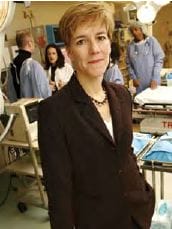 Is Your Team Too Big? Too Small? What’s the Right Number?
Is Your Team Too Big? Too Small? What’s the Right Number?
Wharton management experts debate how team size and composition affect productivity.
When it comes to athletics, sports teams have a specific players: A basketball team needs five, baseball nine, and soccer 11 . But when it comes to the workplace, where teamwork is increasingly widespread throughout complex and expanding organizations there is no hard-and-fast rule to determine the optimal number to have on each team.
Should the most productive team have 4.6 team members, as suggested in a recent article on “How to Build a Great Team” in Fortune magazine? What about naming five or six individuals to each team, which is the number MBA students chosen each year by Wharton for its 144 separate learning teams? Is it true that larger teams simply break down, reflecting a tendency towards “social loafing” and loss of coordination? Or is there simply no magic team number, a recognition of the fact that the best number of people is driven by the team’s task, and by the roles each person plays?
“The size question has been asked since the dawn of social psychology,” says Jennifer S. Mueller, Wharton assistant professor of management, recalling the early work of Maximilian Ringelmann, a French agricultural engineer born in 1861 who discovered that the more people who pulled on a rope, the less effort each individual contributed. Today, “teams are prolific in organizations. From a managerial perspective, there is this rising recognition that teams can function to monitor individuals more effectively than managers can control them. The teams function as a social unit; you don’t need to hand-hold as much. And I think tasks are becoming more complex and global, which contributes to the need for perspective that teams provide.”
Each Person Counts
While the study of team size is one of her areas of concentration, Mueller and other Wharton management experts acknowledge that size is not necessarily the first consideration when putting together an effective team. “First, it’s important to ask what,” Mueller says. Answering that question “will define whom you want to hire, what type of skills you are looking for.”
A sub-category to this is the degree of coordination required. If it’s a sales team, the only real coordination comes at the end. It’s all individual, and people are not interdependent. The interdependence matters, because it is one of mechanisms that you use to determine if people are getting along.” Second, she says, “what is the team composition? What are the skills of the people needed to be translated into action? That would include everything from work style to personal style to knowledge base and making sure that they are appropriate to the task.”

Katherine Klein, Wharton Management Professor
And third, “you want to consider size.” The study of optimal team size seems to fascinate a lot of businesses and academics, primarily due to the fact that “in the past decade, research on team effectiveness has burgeoned as teams have become increasingly common in organizations of all kinds,” writes Wharton management professor Katherine J. Klein, in a paper titled, “Team Mental Models and Team Performance.” The paper, co-authored with Beng-Chong Lim, a professor at Nanyang Business School, Nanyang Technological University, Singapore, was published in January 2006 in the Journal of Organizational Behavior.
In an interview, Klein acknowledgesthat when it comes to team size, each person counts. “When you have two people, is that a team or a dyad? With three, you suddenly have the opportunity to have power battles, two to one. There is some notion that three is dramatically different from two, and there is some sense that even numbers may be different from odd numbers, for the same reason. My intuition is that by the time you are over eight or nine people, it is cumbersome and you will have a team that breaks down into sub-teams. Depending on the group’s task, that could be a good thing or that could not be right. There is a sense that as a team gets larger, there is a tendency for social loafing, where someone gets to slide, to hide.”
Ringelmann’s famous study on pulling a rope—often called the Ringelmann effect—analyzed people alone and in groups as they pulled on rope. Ringelmann then measured the pull force. As he added more and more people to the rope, Ringelmann discovered that the total force generated by the group rose, but the average force exerted by each group member declined, thereby discrediting the theory that a group team effort results in increased effort. Ringelmann attributed this to what was then called “social loafing” —a condition where a group or team tends to “hide” the lack of individual effort.
“After about five people, there are diminishing returns on how much people will pull,” says Mueller. “But people, unless they are not motivated or the task is arbitrary, will not want to show social loafing. If the task is boring and mundane, they are more likely to loaf. If you tell executives this, they say, ‘One of the things I’m worried about is loafing and free riding.’ Whereas social loafing is decreased effort in a group context relative to individual context, free riding is rational and self-interested. If a person is not going to be rewarded, they say, ‘I’m going to free ride’ and they don’t participate as much. The two concepts are hard to distinguish, but they are just different ways to measure
Team Building is Key
Evan Wittenberg, WG’01, director of the Wharton Graduate Leadership Program, notes that team size is “not necessarily an issue people think about analyzed people immediately, but it is important.” According to Wittenberg, while the research on optimal team numbers is “not conclusive, it does tend to fall into the five to 12 range, though some say five to nine is best, and the number six has come up a few times.
But having a good team depends on more than optimal size, Wittenberg adds. For instance, when Wharton assigns five to six MBA students to individual teams, “we don’t just assign those teams. We make sure they can be effective. We have a ‘learning team retreat’ where we take all 800 students out to a camp in the woods in upstate New York and spend two days doing team building and trust building exercises. I think this is what people forget to do when they create a team in a business—spend a lot of time upfront to structure how they will work together.
We get to know each other and share individual core values so we can come up with team values. But most importantly, we have the students work on their team goals, their team norms and their operating principles. Essentially, what are we going to do and how are we going to do it?”
In the work world, says Wittenberg, it has been “reinforced that five or six is the right number (on a team). At least for us, it gives everyone a real work out. But frankly, I think it depends on the task.” Recent research by Mueller would seem to support Wittenberg’s notion that preparation for team success is vital.
In a recent paper, “Why Individuals in Larger Teams Perform Worse,” Mueller channeled Ringelmann’s theories on large group efforts and tried to explain why the title of her paper is true. For decades, researchers have noted that mere changes in team size can change work-group processes and resulting performance. By studying 238 workers within 26 teams, ranging from three to 20 members in size, Mueller’s research replicates the general assertion that individuals in larger teams do perform worse, but she also offers an explanation for this conclusion.
“Understanding the reasons why individuals in larger teams in real work settings perform worse may be one key to implementing successful team management tactics in organizations, since research shows that managers tend to bias their team size toward overstaffing,” she writes. In addition, “individual performance losses are less about coordination activities and more about individuals on project teams developing quality relationships with one another as a means of increasing individual performance. Because research on teams in organizations has not examined team social support as an important intra-team process, future research should examine how team social support fits in with classic models of job design to buffer teams from negative influences and difficulties caused by larger team size.”
But is there an optimal team size? Mueller has concluded, again, that it depends on the task. “If you have a group of janitors cleaning a stadium, there is no limit to that team; 30 will clean faster than five.” But, says Mueller, if companies are dealing with coordination tasks and motivational issues, and you ask, ‘What is your team size and what is optimal?’ that correlates to a team of six. “Above and beyond five, and you begin to see diminishing motivation,” says Mueller. “After the fifth person, you look for cliques. And the number of people who speak at any one time? That’s harder to manage in a group of five or more.”

























